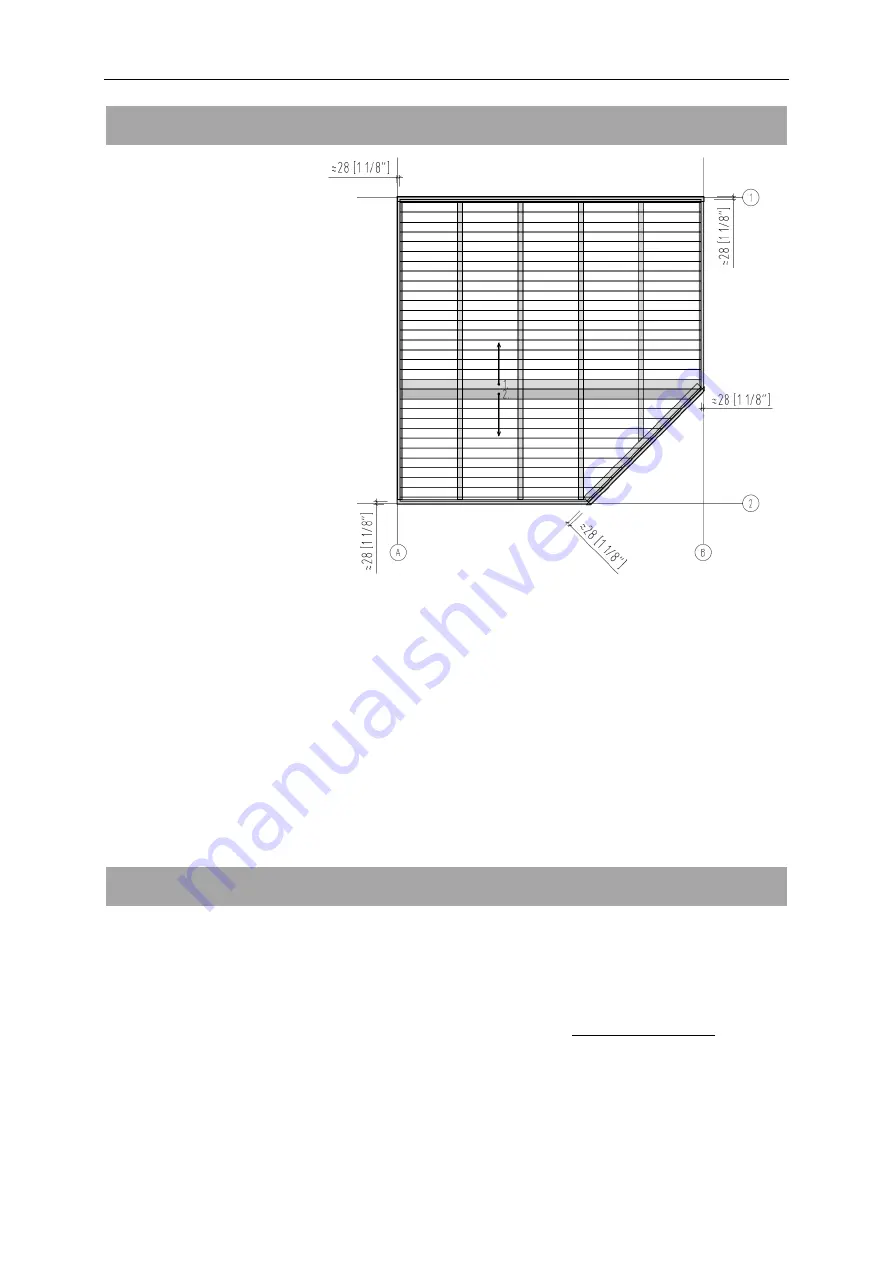
Installation manual – English
Floor
Install the floor right after
foundation bearers have been
placed into position and
screwed together. Cover the
floor for the assembling time
thus avoiding unnecessary
smudging on the floor.
Start assembling the floor as
shown on the drawing moving
in both directions. If necessary,
cut the last boards of the sides
to suitable width.
When placing floor boards,
please note that the boundary
line of floor boards must be all
around the floor 27 mm
(1 1/16”) inside from external
edge of foundation bearers. It
will guarantee that the first
layer of wall logs will fit on the
base frame.
Floor boards should be fixed to
every foundation bearer with
nails 2,5x50 mm (3/32”x2”).
For nicer finish we suggest to
nail the boards from top part of
the tongue so the head of the
nail will be covered with groove
of next board.
The final operation is the fitting of the floor beadings to cover the spaces between the floor boards and
walls. If necessary, cut the floor beadings to the suitable length.
ATTENTION
: Depending on the climate at the house location, the floor boards can either swell or
diminish. If the floor boards are very dry while the climate is damp, they will easily absorb moisture. In
this case, the floor boards should not be attached very densely to avoid likely bulging. Leave some
space (1–2 mm (3/64”–5/64”)) between the floor boards to allow for swelling. But if your climate is warm
and dry, you can install the boards densely because they will become drier and spaces may appear
between them.
Walls
When installing the walls, it is important to remember that:
➢
The logs are always assembled with their tongue upwards!
➢
Never directly hit the tongue with the hammer!
If necessary, use the hitting block and hammer!
Install the walls in accordance with the appended wall plans (see Technical specifications).
First of all place half logs at the correct location (see
Technical specifications) and attach them with screws to the
foundation joists. Then install the side wall logs. Make sure
that the first layer of logs extends a bit over the foundation
joists: the logs must extend over the joists by some 3–10 mm
(1/8”–3/8”) depending on a wall thickness (please see the
drawing). You will thus protect the house from moisture,
allowing the free flow of rainwater into the ground.
The first layer of logs:
Summary of Contents for Palmako PA28-3030
Page 3: ......
Page 4: ......
Page 5: ......
Page 6: ......
Page 7: ......
Page 8: ...AS Palmako N ituse 25 Tartu 50409 Estonia tel 372 73 55 530 fax 372 73 55 544 www palmako com...
Page 9: ...AS Palmako N ituse 25 Tartu 50409 Estonia tel 372 73 55 530 fax 372 73 55 544 www palmako com...
Page 10: ...AS Palmako N ituse 25 Tartu 50409 Estonia tel 372 73 55 530 fax 372 73 55 544 www palmako com...
Page 11: ...AS Palmako N ituse 25 Tartu 50409 Estonia tel 372 73 55 530 fax 372 73 55 544 www palmako com...
Page 12: ...AS Palmako N ituse 25 Tartu 50409 Estonia tel 372 73 55 530 fax 372 73 55 544 www palmako com...
Page 13: ...AS Palmako N ituse 25 Tartu 50409 Estonia tel 372 73 55 530 fax 372 73 55 544 www palmako com...
Page 14: ...AS Palmako N ituse 25 Tartu 50409 Estonia tel 372 73 55 530 fax 372 73 55 544 www palmako com...
Page 15: ...Pst2 Pst1 Sla1...
Page 16: ...5x90 3 16 x3 9 16 4pcs 5 1 2 5 50 2 3 1 6 3 16...
Page 17: ...A A A A 40 TU28 61P 009 010 Rel 1 3 5x50 x3 1 9 16 1 8 x2...
Page 18: ...3 5x50 3 5x50 010 009 5x90 x3 5x90 x3 1 8 x2 1 8 x2 3 16 x3 9 16 3 16 x3 9 16...
Page 19: ...UP3 UP2 UP1 UP2 UP3 UP1 Det1 RoR2 RoR1 RoR1 RoR2 RoR3 RoR3 RoR3...
Page 21: ...5x90 3 1 2 5x90 Det1 3 16 x3 9 16 3 16 x3 9 16 1 8...
















































